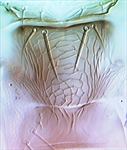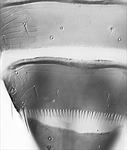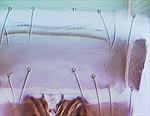
Head & pronotum

Antennal segments II–VIII

Metanotum

Abdominal tergites VII–VIII

Abdominal sternite VII

Male sternites IV–V

Fore wing
Both sexes fully winged. Body brown, legs yellow with extensive brown shadings particularly on femora, antennal segment III yellow, IV–V variably yellow and brown, fore wings pale but weakly shaded. Antennae 8-segmented, segment I with a pair of small dorso-apical setae; III & IV each with a forked sense cone. Head slightly longer than wide, 3 pairs of ocellar setae present, III almost twice as long as lateral margin of ocellar triangle, arising close to anterolateral margin. Pronotum with 2 pairs of posteroangular setae. Metanotum irregularly reticulate, posterior reticles smallest, median setae at anterior margin and more than two-thirds as long as metanotum, paired campaniform sensilla absent. Fore wing first vein with only 2 setae on distal half, second vein with 14–16 setae. Abdominal tergites with sculpture lines scarcely extending mesad to campaniform sensilla, without ctenidia; tergite VIII with long regular marginal comb. Sternites without discal setae, marginal setae as long as sternites; sternite VII setae S1 and S2 arising well in front of margin.
Male smaller, sternites III–VII each with about 12 small pore plates in two irregular transverse rows.
The genus Ceratothripoides currently includes five species from Africa and the Oriental region. However, the distinction between the Oriental species C. claratris and the African species C. cameroni remains equivocal (Mound & Nickle, 2009). Species in Ceratothripoides have a pair of small setae dorsally near the apex of the first antennal segment, but otherwise are similar in appearance to species of Ewartithrips and Tenothrips. A further member of the genus, Ceratothripoides brunneus, that is widespread in Africa, has been studied from Puerto Rico as well as Malaysia and is a potential invader of USA - it is readily distinguished by the uniformly brown fore wings.
Breeding in flowers, on young fruits, and on leaves of various plants, but reported as causing considerable damage to tomato plants in Thailand (Premachandra et al., 2004). Reported to be a vector of Capsicum chlorosis virus (Premachandra et al., 2005).
India to Thailand, but a potentially invasive species in horticultural trade.
THRIPIDAE - THRIPINAE
Ceratothripoides claratris (Shumsher)
Taeniothrips claratris Shumsher, 1946: 178
Mycterothrips moultoni Seshadri & Ananthakrishnan, 1954: 213
Ceratothrips reticulatus Reyes, 1994: 183
Mound LA & Nickle DA (2009) The Old-World genus Ceratothripoides (Thysanoptera: Thripidae) with a new genus for related New-World species. Zootaxa 2230: 57–63.